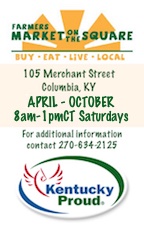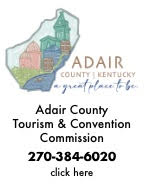| ||||||||||
Dr. Ronald P. Rogers CHIROPRACTOR Support for your body's natural healing capabilities 270-384-5554 Click here for details 


Columbia Gas Dept. GAS LEAK or GAS SMELL Contact Numbers 24 hrs/ 365 days 270-384-2006 or 9-1-1 Call before you dig Visit ColumbiaMagazine's Directory of Churches Addresses, times, phone numbers and more for churches in Adair County Find Great Stuff in ColumbiaMagazine's Classified Ads Antiques, Help Wanted, Autos, Real Estate, Legal Notices, More... 

|
Tom Chaney No. 255:Rolling Down the Rivers Of Writers and Their Books, No. 255: 23 May 2010, a review of books on Rolling Down the Rivers The next earlier Tom Chaney column, an essay on It's Not That We Forgot.... We Never Knew By Tom Chaney Email: Tom Chaney bookstore@scrtc.com Rolling Down the Rivers In 1937 editor Constance Lindsay Skinner outlined a brave new series of books for Farrar & Rinehart. That year her firm published Kennebec: Cradle of Americans by Robert P. Tristram Coffin thus launching their Rivers of America project. In an essay in the early volumes Skinner described the series as follows: "This is to be a literary and not a historical series. The authors of these books will be novelists and poets. On them, now in America, as in all lands and times, rests the real responsibility of interpretation. If the average American is less informed about his country than any other national, knows and cares less about its past and about its present in all sections but the one where he resides, it is because books prepared for his instruction were not written by artists."Skinner planned twenty-four volumes. The series extended to sixty-five over the next 37 years. She died whilst editing the sixth volume. The series extended beyond the lifetime of two publishing companies. In 1946 Farrar & Rinehart became Rinehart & Co. which in 1960 became Holt, Rinehart & Winston. I have, over the years, read of only three rivers -- four books counting "The Tennessee" twice. Whenever I come across another, I get it and stash it on the "to be read" shelf. The study that sticks most in my memory after some 35 years is the two-volume set on the Tennessee by Donald Davidson. Published by Rinehart & Co. in 1946, The Tennessee: the Old River, is a beautiful tribute to the free-flowing Tennessee from pioneer days up through steamboat times -- times when the South was being settled, fighting in the Civil War, with farmers plowing their fields in a kind of idyllic Eden lived to the gentle strum of the banjo and the raucous fiddle. Seed time and flood time followed in a cosmic rhythm of earth -- bound by the river. Two years later comes The Tennessee: the New River, also by Davidson. The serpent has entered Eden in the shape of the Tennessee Valley Authority. TVA dammed the river thus damning the very soul of the valley, according to Davidson. The farmer has traded his mule and wagon for a Ford car and hung up the fiddle to listen to the radio. The harsh glare of the electric light replaced the soft glow of candle and lantern. Nonetheless it is gloriously written. But of course, it would be. Davidson was one of the young poets cum agrarians who swirled around the campus of Vanderbilt University in Nashville during the 1920s and 1930s, and one of the more vocal contributors to the agrarian manifesto I'll Take My Stand, published in 1935. Students and teachers in that era included some of the finest craftsmen of words of the twentieth century: Robert Penn Warren, Allen Tate, John Crowe Ransom -- to name but three. Those three were taught by their agrarian roots, but did not become its slaves. Davidson was unreconstructed -- his lovely old river seemed to have become merely a drainage ditch for the power plants. I think my favorite came in 1941. Thomas D. Clark had not the TVA ax to grind of Donald Davidson. Though a historian he ever wrote with the pen of the artist bringing the three forks of The Kentucky together as the river flows from the eastern mountains to water the politicians in Frankfort then depositing the state's detritus into the Ohio at Carrollton. Most recently I've been reading The Arkansas by Clyde Brion Davis [1940]. That river is a bit different from either the Kentucky or the Tennessee. Until I read Davis, I always thought of the Arkansas as the languid river which bisects the state whose name it bears. Wrong! Tom! The young razorback river comes to life just a brief way east of the Continental Divide and the Colorado River -- in the Rockies near Freemont, Colorado. It does the buck and wing down from high places until, exhausted, it crosses the plains of Kansas, cuts a corner through Oklahoma into its name sake near Fort Smith. By the time the Arkansas empties, deep and tired, into the Mississippi it has drained its banks of silver and gold, sluiced down Cripple Creek, fought civil war in Colorado as well as the south, to end with carpetbaggers, lynching, and catfish. Davis tells a good tale, but I was left wanting a bit more. He seems to have used the river on the map on which to pin interesting stories without making the Arkansas always the necessary cause or the result of the events in the land which it drains. No matter. Any river which drops nigh two miles from start to finish is storied enough for me. Tom Chaney can be found telling stories, planning his next meal, and occasionally selling books at THE BOOKSTORE This story was posted on 2010-05-23 09:51:57
Printable: this page is now automatically formatted for printing.
Have comments or corrections for this story? Use our contact form and let us know. More articles from topic Tom Chaney: Of Writers and Their Books:
Tom Chaney No. 254: It's Not That We Forgot.... We Never Knew Tom Chaney No. 253: Though You Kill Me, I Must Bury My Brother! Tom Chaney No. 252: The Art of Ken Follett Tom Chaney No. 251: a review of Generations Tom Chaney No. 250: And Finally, Spring Tom Chaney No. 249, 11 April 2010: Ralph McInerny Tom Chaney No. 248, 4 April 2010: Out in the Country Tom Chaney No. 247, 28 March 2010: Billboard dreaming Tom Chaney No. 246, 21 March 2010: Down these mean streets... Tom Chaney No. 245, 14 March 2010: Fragments of deceit View even more articles in topic Tom Chaney: Of Writers and Their Books |


|
||||||||
|
| ||||||||||
|
Quick Links to Popular Features
Looking for a story or picture? Try our Photo Archive or our Stories Archive for all the information that's appeared on ColumbiaMagazine.com. | ||||||||||
|
Contact us: Columbia Magazine and columbiamagazine.com are published by Linda Waggener and Pen Waggener, PO Box 906, Columbia, KY 42728. Please use our contact page, or send questions about technical issues with this site to webmaster@columbiamagazine.com. All logos and trademarks used on this site are property of their respective owners. All comments remain the property and responsibility of their posters, all articles and photos remain the property of their creators, and all the rest is copyright 1995-Present by Columbia Magazine. Privacy policy: use of this site requires no sharing of information. Voluntarily shared information may be published and made available to the public on this site and/or stored electronically. Anonymous submissions will be subject to additional verification. Cookies are not required to use our site. However, if you have cookies enabled in your web browser, some of our advertisers may use cookies for interest-based advertising across multiple domains. For more information about third-party advertising, visit the NAI web privacy site.
| ||||||||||




















































